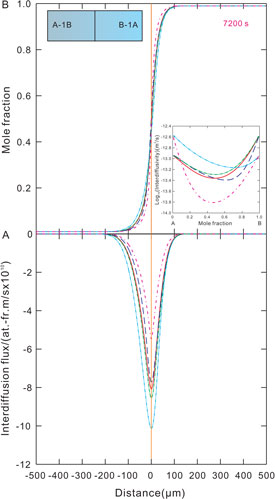Crossref Citations
This article has been cited by the following publications. This list is generated based on data provided by
Crossref.
Liu, Yuling
Chen, Chong
Liu, Dandan
Du, Yong
Liu, Shuhong
Tao, Xiaoma
and
Ouyang, Yifang
2017.
Diffusivities and atomic mobilities for fcc Cu–Ni–Sn alloys.
Calphad,
Vol. 59,
Issue. ,
p.
84.
Wen, Shiyi
Tang, Ying
Zhong, Jing
Zhang, Lijun
Du, Yong
and
Zheng, Feng
2017.
High-throughput measurements of interdiffusivity matrices in face centered cubic Ni–Al–Mo alloys at 1273–1473 K.
Journal of Materials Research,
Vol. 32,
Issue. 11,
p.
2188.
Deng, Shuwen
Chen, Weimin
Zhong, Jing
Zhang, Lijun
Du, Yong
and
Chen, Li
2017.
Diffusion study in bcc_A2 Fe-Mn-Si system: Experimental measurement and CALPHAD assessment.
Calphad,
Vol. 56,
Issue. ,
p.
230.
Chen, Weimin
and
Zhang, Lijun
2017.
High-Throughput Determination of Interdiffusion Coefficients for Co-Cr-Fe-Mn-Ni High-Entropy Alloys.
Journal of Phase Equilibria and Diffusion,
Vol. 38,
Issue. 4,
p.
457.
Zhang, Li Jun
Chen, Juan
Chen, Wei Min
Ta, Na
and
Li, Qin
2017.
Interdiffusion Databanks of γ, γ′ and β Phases in NiAl-Based Ternary Systems.
Diffusion Foundations,
Vol. 13,
Issue. ,
p.
136.
Li, Qin
Chen, Weimin
Zhong, Jing
Zhang, Lijun
Chen, Qing
and
Liu, Zi-Kui
2017.
On Sluggish Diffusion in Fcc Al–Co–Cr–Fe–Ni High-Entropy Alloys: An Experimental and Numerical Study.
Metals,
Vol. 8,
Issue. 1,
p.
16.
Chen, Weimin
Li, Qin
and
Zhang, Lijun
2017.
A Novel Approach to Eliminate the Effect of External Stress on Interdiffusivity Measurement.
Materials,
Vol. 10,
Issue. 8,
p.
961.
Chen, Weimin
Zhang, Lijun
Li, Wei
and
Du, Yong
2018.
Experimental measurements of the interdiffusivities in fcc Co–rich Co–Ti, Co–W and Co–Ti–W systems.
International Journal of Refractory Metals and Hard Materials,
Vol. 71,
Issue. ,
p.
153.
Chen, Juan
and
Zhang, Lijun
2018.
Composition-dependent interdiffusivity matrices in face centered cubic Ni–Al–X (X = Rh and W) alloys at 1423, 1473 and 1523 K: A high-throughput experimental measurement.
Calphad,
Vol. 60,
Issue. ,
p.
106.
Wang, Rui
Chen, Weimin
Zhong, Jing
and
Zhang, Lijun
2018.
Experimental and numerical studies on the sluggish diffusion in face centered cubic Co-Cr-Cu-Fe-Ni high-entropy alloys.
Journal of Materials Science & Technology,
Vol. 34,
Issue. 10,
p.
1791.
Chen, Wei Min
Yang, Xiong
and
Zhang, Li Jun
2018.
Phenomenological Investigations on Diffusion Kinetics in Multicomponent Metallic Melts.
Diffusion Foundations,
Vol. 15,
Issue. ,
p.
23.
Chen, Weimin
2018.
Interdiffusion and atomic mobility in bcc Ti–rich Ti–Nb–Zr system.
Calphad,
Vol. 60,
Issue. ,
p.
98.
Chen, Weimin
Li, Wei
and
Du, Yong
2018.
Investigations on diffusion behaviors in Ti–rich Ti–Nb–Zr–Cr system: Experimental measurement and CALPHAD modeling.
Calphad,
Vol. 62,
Issue. ,
p.
223.
Cheng, Kaiming
Zhou, Jixue
Xu, Huixia
Tang, Shouqiu
and
Yang, Yuansheng
2018.
An effective method to calculate the composition-dependent interdiffusivity with one diffusion couple.
Computational Materials Science,
Vol. 143,
Issue. ,
p.
182.
Tang, Ying
Chen, Qing
and
Engström, Anders
2018.
Kinetic Simulations of Diffusion-Controlled Phase Transformations in Cu-Based Alloys.
Diffusion Foundations,
Vol. 15,
Issue. ,
p.
1.
Divinski, Sergiy V.
Pokoev, Alexander V.
Esakkiraja, Neelamegan
and
Paul, Aloke
2018.
A Mystery of "Sluggish Diffusion" in High-Entropy Alloys: The Truth or a Myth?.
Diffusion Foundations,
Vol. 17,
Issue. ,
p.
69.
Chen, Wei Min
and
Zhang, Li Jun
2018.
High-Throughput Determination of Interdiffusivities for Ni-Al-Cr Alloys at 1173 K through a Combination of Diffusion Multiple and Numerical Inverse Method.
Defect and Diffusion Forum,
Vol. 383,
Issue. ,
p.
36.
Chen, Juan
Zhang, Lijun
and
Lu, Xiao-Gang
2018.
Diffusion behaviors of Rh, Ta, W, Re, Os and Ir in ternary L12-Ni3Al alloys.
Intermetallics,
Vol. 102,
Issue. ,
p.
11.
Chen, Juan
Zhang, Lijun
and
Lu, Xiao-Gang
2018.
Screening of Possible Re-Substitutional Elements in Single-Crystal Ni-Based Superalloys: A Viewpoint From Interdiffusion Coefficients in Ni-Al-X Ternaries.
Metallurgical and Materials Transactions A,
Vol. 49,
Issue. 7,
p.
2999.
Chen, Shiyao
Li, Qin
Zhong, Jing
Xing, Fangzhou
and
Zhang, Lijun
2019.
On diffusion behaviors in face centered cubic phase of Al-Co-Cr-Fe-Ni-Ti high-entropy superalloys.
Journal of Alloys and Compounds,
Vol. 791,
Issue. ,
p.
255.
